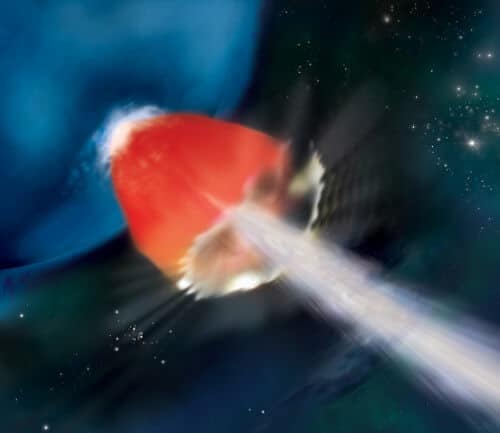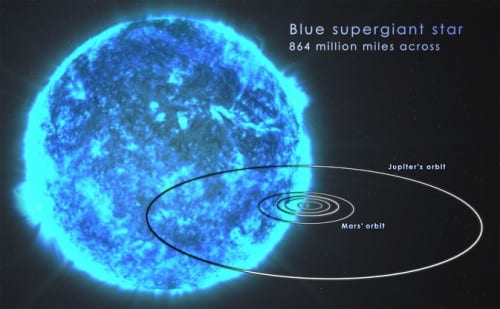This eruption, which occurred on September 25, 2013, was a thousand times longer than the average eruption of the long type, so it is considered a third type, and originated from blue giants that did not lose their hydrogen atmosphere before becoming a black hole

Astronomers analyzing a long burst of high-energy light observed in 2013 reported that they discovered characteristics remarkably similar to those expected from the explosion of one of the first stars in the universe. If the interpretation is correct, this burst will confirm ideas about a relatively new type of gamma-ray bursts and will be used for future observations of what appears to be the first act of the first stars.
One of the great challenges of modern astrophysics was the attempt to identify the stars of the first generation created in the universe, also known as type III stars" explains Luigi Piro, director of the auction at the Institute of Astrophysics and Planets in Rome, a division of the Italian National Institute of Astrophysics (INAF). "This important event brings us another step closer in the direction" he added.
Gamma-ray bursts are the most powerful explosions in the universe. Such an eruption emits gamma rays - the most energetic form of light and X-rays and produces radiation that rapidly fades and which can be observed in visible light, infrared light and radio waves. On average, the European Space Agency's Fermi detector on NASA's Swift satellite and other telescopes detect one gamma-ray burst per day.
On September 25, 2013, the Halvin Swift Alert Telescope alerted to a Schlecknerig Ma wave from a source in the constellation Fornax. The spacecraft automatically alerted viewers around the world about the new burst, known as GRB 130925A. Swift then pointed her X-ray telescope at the source. Other satellites also began to follow the rising wave of high-energy radiation, including the European Fermi, the Russian Konos instrument on board NASA's WIND spacecraft and the European Space Agency's Integral Space Observatory.
The burst was finally located in a galaxy so far away that it takes light from it 3.9 billion years to reach us.
Astronomers have observed many gamma ray bursts over the past five decades. Until recently, they classified them into two groups according to the length of the outbreak - short or long. Short bursts, lasting 2 seconds or less, result from the merger of two compact stars in a binary star system usually involving a neutron star and black hole process. Long bursts last from a few seconds to several minutes, with typical bursts ranging from 20 to 50 seconds. These eros are considered to be related to the explosion of stars several times larger than the Sun and at the end of which a black hole was born.
In contrast, the burst GRB 130925A lasted almost two hours, over a thousand times longer than a typical burst. Observations by Swift's XRT instrument revealed a glow in large areas of X-rays for six hours. After them, the object began to fade gradually, as occurs in any long gamma ray burst.
GRB 130925A" is a member of a new and rare type of extremely long gamma-ray bursts," says Eleonora Troy, a senior researcher at NASA's Goddard Center in Maryland and a member of the research team. "What sets it apart is the duration of the X-ray glow, which provides the particularly strong evidence that the extremely long gamma-ray bursts come from blue giant stars.

Astronomers believe that Wolf-Rayet stars are the best explanation for long bursts. Most of them have a mass 25 times that of the Sun or more. These stars are so hot that they shed their outer hydrogen envelopes through the solar wind. By the time they collapse, the star's outer atmosphere has already cooled and its physical size is similar to that of the Sun. A black hole forms inside the star's core and the material falling in produces jets that pass through the entire star. The jets continue to operate for several tens of seconds - the duration of a long burst of gamma rays.
Since the extremely long gamma-ray bursts last several hundreds of times longer, their source must be a correspondingly much larger star. The prime suspects are blue giants, stars with 20 times the mass of the Sun that retain their hydrogen atmospheres and are therefore 100 times the diameter of the Sun. Moreover, blue giant stars contain very few elements heavier than helium, which astrophysicists call all metal clusters. A large metal content controls the strength of the solar wind, which in turn determines how much of the hydrogen atmosphere will remain in the star before it collapses. In blue giant stars, it takes many hours for the hydrogen shell to fall into the black hole, providing a stable power source for an extremely long burst.
In an article published on July 10 in the Astrophysical Journal Letters, the researchers note that the observations of the radio rays emitted by the eruption lasted for about six months, while in four months they maintained a constant rate. The very slow decay led researchers to hypothesize that the outburst created waves moving freely through space, indicating that the star's environment is free of material ejected by its solar wind or neighboring stars.

One response
It seems that the distance estimate of 9^10*3.9 light years is wrong, if it is indeed a first generation star.
Although this is the number also stated in the original NASA article, first generation stars are supposed to be much further away, about 3 times.